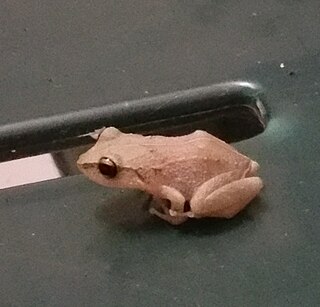Craugastor guerreroensis, also known as the Guerreran robber frog, is a species of frog in the family Craugastoridae. It is endemic to Mexico and only known from its type locality near Agua del Obispo, in the municipality of Chilpancingo de los Bravo, Guerrero.
Eleutherodactylus amadeus, also known as Mozart's frog or Haitian robber frog, is a species of frog in the family Eleutherodactylidae. It is endemic to the Massif de la Hotte, southwestern Haiti. After not having been seen after 1991, the species was reported again in 2011.
Eleutherodactylus auriculatoides is a species of frog in the family Eleutherodactylidae endemic to the Cordillera Central in the Dominican Republic. Its natural habitats are montane closed forest. It is an arboreal species often found in bromeliads. Habitat loss caused by agriculture and charcoal production is the main threat to it. Its presence is uncertain in Haiti.

Eleutherodactylus flavescens is a species of frog in the family Eleutherodactylidae endemic to the eastern Dominican Republic. Its natural habitats are mesic forest, and occasionally, mangroves. It is a very common frog in suitable habitat, but has declined in parts of its range. It is threatened by habitat loss caused by infrastructure development and agricultural encroachment.
The khaki bromeliad frog or Fowler's robber frog is a species of frog in the family Eleutherodactylidae endemic to Hispaniola. It occurs in the Massif de la Selle and is known from one site in the Dominican Republic and one in Haiti. It is named after Danny C. Fowler, collector of the holotype.
Eleutherodactylus glaphycompus is a species of frog in the family Eleutherodactylidae endemic to the Tiburon Peninsula, Haiti. Its common name is Southwest Haiti robber frog. The specific name glaphycompus refers to its microhabitat, fissures and crevices in limestone rock.
The half-stripe bromeliad frog or Shreve's robber frog is a species of frog in the family Eleutherodactylidae endemic to Hispaniola and found in both the Dominican Republic and Haiti. Its natural habitats are subtropical or tropical moist lowland forest and subtropical or tropical moist montane forest. It is threatened by habitat loss.
The Baoruco burrowing frog, or Cabral robber frog, is a species of frog in the family Eleutherodactylidae. It is endemic to Hispaniola where it is found on the Tiburon Peninsula, Haiti and eastward to the Baoruco Mountain Range, Dominican Republic. Its natural habitat is closed mesic broadleaf forest, but it can also occur at shade-grown coffee and cacao plantations. It is a burrowing species. Males call from constructed underground chambers; also the eggs are laid underground. threatened by habitat loss, even within the Sierra de Bahoruco National Park.
Eleutherodactylus inoptatus is a species of frog in the family Eleutherodactylidae endemic to Hispaniola; it is found both in Haiti and the Dominican Republic. With female snout–vent length of about 88 mm (3.5 in), it is the largest eleutherodactylid frog.
The La Selle dusky frog or Mable's robber frog, Eleutherodactylus jugans, is a species of frog in the family Eleutherodactylidae. It is endemic to Hispaniola and known from the Massif de la Selle, both in the Dominican Republic and in Haiti. Its natural habitats are mesic pine and broadleaf forests. It is threatened by habitat loss. It is moderately common in suitable habitat, but threatened by habitat loss caused by logging and agriculture. It is known from both La Visite National Park (Haiti) and Sierra de Bahoruco National Park, but habitat degradation is occurring in these areas too.

The southern pastel frog or Hispaniola robber frog, Eleutherodactylus leoncei, is a species of frog in the family Eleutherodactylidae. It is endemic to Hispaniola and known from the Massif de la Selle, both in the Dominican Republic and in Haiti. Its natural habitats are upland pine forests. Males call from the ground. It is threatened by habitat loss caused by logging and agriculture. It is known from the Sierra de Bahoruco National Park, but habitat degradation is occurring in this area too.

Eleutherodactylus minutus, also known as the Hispaniolan wheeping frog, is a species of frog in the family Eleutherodactylidae endemic to the Cordillera Central, Dominican Republic, at elevations of 879–2,300 m (2,884–7,546 ft) asl. Its common name is tiny robber frog. Its natural habitats are mesic upland broadleaf or pine forests. In suitable habitat it is moderately common. It is threatened by habitat loss caused by agriculture.
Eleutherodactylus montanus is a species of frogs in the family Eleutherodactylidae endemic to the Cordillera Central, Dominican Republic, at elevations of 1,270–2,424 m (4,167–7,953 ft) asl. Its common name is Dominican mountain robber frog. Its natural habitat is closed-canopy forest and forest remnants. It is typically found in the fern understorey; males call from low vegetation. It is threatened by habitat loss caused by agriculture and by disturbance from ecotourism.
The spiny giant frog or Norton's robber frog, Eleutherodactylus nortoni, is a species of frog in the family Eleutherodactylidae. It is named after James W. Norton who accompanied Albert Schwartz in his 1974 expedition to Hispaniola and collected the holotype.

The Hispaniolan yellow-mottled frog or painted robber frog, Eleutherodactylus pictissimus, is a species of frog in the family Eleutherodactylidae endemic to Hispaniola and found in both the Dominican Republic and Haiti. Its natural habitats are dry scrub forest, mesic broadleaf forest, and secondary forest. It is a terrestrial frog that lays its eggs on the ground. It is threatened by habitat loss.

Eleutherodactylus pinchoni is a species of frog in the family Eleutherodactylidae. It is endemic to Guadeloupe and known from the Basse-Terre. Common name Grand Cafe robber frog has been coined for it.
Eleutherodactylus pituinus is a species of frog in the family Eleutherodactylidae endemic to the Cordillera Central, Dominican Republic, at elevations of 1,212–1,770 m (3,976–5,807 ft) asl. Its natural habitats are upland pinewoods and forests. It is threatened by habitat loss caused by agriculture and by disturbance from ecotourism. Also chytridiomycosis is a threat.
Eleutherodactylus schmidti is a species of frog in the family Eleutherodactylidae endemic to Hispaniola, and found in both the Dominican Republic and Haiti. It is sometimes referred to as the Schmidt's robber frog. It is named in honour of Karl Patterson Schmidt.
Eleutherodactylus wetmorei is a species of frog in the family Eleutherodactylidae.

Ruth Crosby Noble was an American author and herpetologist. Working for the American Museum of Natural History, she and her husband Gladwyn Kingsley Noble discovered a new species of frog, the Eleutherodactylus ruthae, named for her. Noble later authored The Nature of the Beast, a book on animal behavior.







